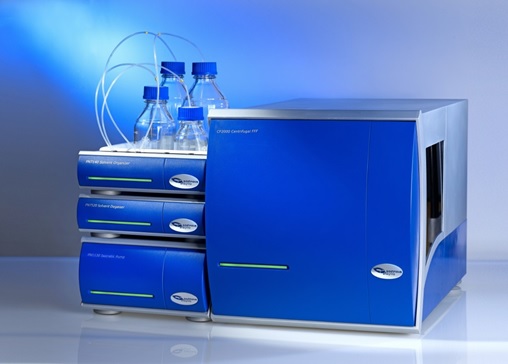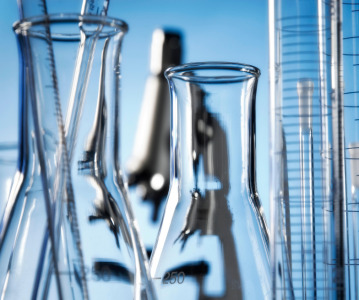Technique improves drug delivery system characterization

Postnova Analytics' CF2000 Centrifugal Field Flow Fractionation (CF3) system is delivering exciting new data to scientists developing drug delivery systems.
The determination of cargo mass per delivery vesicle is one of the big challenges of characterization of any drug delivery system. Size characterization techniques are inherently inadequate to provide such information. By comparison, Postnova Analytics has found that its CF2000 CF3 system, a mass-based, high-resolution separation instrument, is capable of measuring the cargo mass per vesicle to a limit of quantification of 12 attogram (12 x 10-18 g).
In CF3, the separation force is established by a centrifugal field, which is generated by spinning the complete circular channel at a high rate. The bigger and denser particles are forced more in the direction of the outer wall than the smaller particles. As a consequence, bigger particles are eluted later from the CF3 channel as they are located in slower streamlines in the channel than the smaller particles which are located in faster streamlines.
Based on the CF3 principle, the Postnova CF2000 employs a centrifugal field as the driving force for separations. Particles affected by this field are separated by dynamic diffusion on the basis of both particle size and density. This unique feature of the CF2000 allows the separation of different particulate materials having the same particle size.
Separations on the CF2000 can be further optimized by using different eluents and temperature programs. As a consequence, the CF2000 system is proving an ideal tool for the separation and characterization of complex particulate samples in areas including pharmaceutical drug delivery systems.
In contrast to traditional particle sizing techniques, which work in the batch mode, the CF3 technique physically separates each particle fraction prior to sizing. This avoids numerous disadvantages of these batch techniques such as low size resolution, discrimination and under estimation of smaller compared to larger particles.
Using Postnova CF3 technology bypasses the necessity for special sample preparation as they can be injected directly without filtration, allowing the characterization of even complex particulate materials without alteration and damage.
Related News
-
News Ophthalmologic drug product Eylea faces biosimilar threats after FDA approvals
Regeneron Pharmaceutical’s blockbuster ophthalmology drug Eylea is facing biosimilar competition as the US FDA approves Biocon’s Yesafili and Samsung Bioepis/Biogen’s Opuviz. -
News ONO Pharmaceutical expands oncology portfolio with acquisition of Deciphera
ONO Pharmaceutical, out of Japan, is in the process of acquiring cancer-therapy maker Deciphera Pharmaceuticals for US$2.4 billion. -
News First offers for pharma from Medicare drug price negotiations
Ten high-cost drugs from various pharma manufacturers are in pricing negotiations in a first-ever for the US Medicare program. President Biden’s administration stated they have responded to the first round of offers. -
News Eli Lilly’s Zepbound makes leaps and bounds in weight-loss drug market
In the last week, Eli Lilly has announced their partnership with Amazon.com’s pharmacy unit to deliver prescriptions of Zepbound. Zepbound has also surpassed Novo Nordisk’s Wegovy for the number of prescriptions for the week of March 8.&nbs... -
News Chasing new frontiers at LEAP – The National Biotechnology Strategy Keynote
On the third day of LEAP (4–7 March 2024, Riyadh Exhibition and Convention Centre, Malham, Saudi Arabia) the CPHI Middle East team hosted the Future Pharma Forum, to set the scene for an exciting new event for the pharma community, coming to Riya... -
News Pfizer maps out plans for developing new oncology therapeutics by 2030
Pfizer dilvulges plans to investors around growing their cancer portfolio, and the drugs they will be focusing on developing after their aquisition of Seagen in 2023. -
News Generics threat to Merck’s Bridion as Hikma seeks pre-patent expiry approval
Merck has disclosed they received notice from Hikma Pharmaceuticals for seeking a pre-patent expiry US FDA approval for Hikma’s generic version of Merck’s Bridion. -
News Bernie Sanders vs Big Pharma - the latest on drug price negotiations
In a hearing in front of the US Senate, three of the biggest pharmaceutical companies in America are challenged over exorbitant prescription drug prices, with Sanders claiming their actions are limiting the population's access to affordable healthc...
Position your company at the heart of the global Pharma industry with a CPHI Online membership
-
Your products and solutions visible to thousands of visitors within the largest Pharma marketplace
-
Generate high-quality, engaged leads for your business, all year round
-
Promote your business as the industry’s thought-leader by hosting your reports, brochures and videos within your profile
-
Your company’s profile boosted at all participating CPHI events
-
An easy-to-use platform with a detailed dashboard showing your leads and performance
.png)

.png)
.png)


.png)
.png)